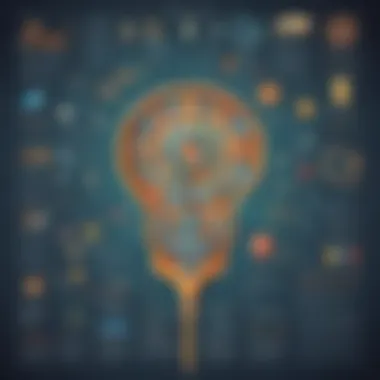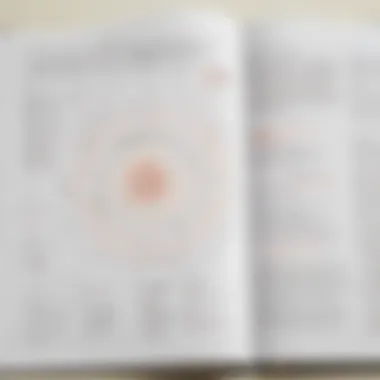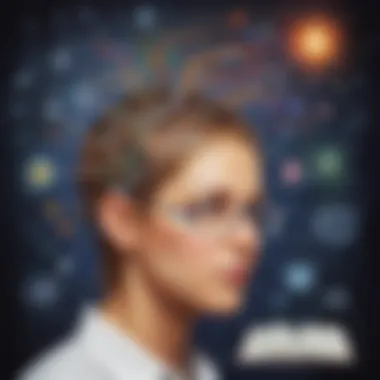Decoding Research Articles: A Young Reader's Guide


Intro
Understanding research articles might seem challenging, but it is very important. For young minds eager to learn, recognizing the purpose and structure of these documents opens up an entire world of knowledge. Learning to interpret these texts strengthens analytical skills and inspires curiosity in various scientific fields.
Research articles are foundational resources in academia. They present original findings, methods, and insights. By embracing these materials, young learners can appreciate the intricacies of science. This journey combines observation, analysis, and reasoning, making the process not only accessible but also enriching for all young science enthusiasts.
Science Fun Facts
Learning science can be exciting, especially when it's backed by fun facts.
- Did you know that honey never spoils? Archaeologists found pots of honey in ancient Egyptian tombs that are more than 3000 years old and still perfectly edible.
- The shortest war in history lasted only 38 to 45 minutes. This was the Anglo-Zanzibar War in 1896.
- More people are killed each year by falling coconuts than by shark attacks. It may sound strange, but it is true!
By understanding interesting trivia, the foundational aspect of research becomes clearer and more relatable.
Discover the Wonders of Science
Science isn't just about reading articles. It's about exploring various concepts.
Some important ways to discover science include:
- Educational Videos and Animations: Websites like Wikipedia offer animation and visual learning that can enhance understanding.
- Interactive Learning Tools: Using digital apps for sciences can create a more engaging learning curve.
- Real-Life Applications of Science: Learning how principles apply in daily life can make research papers more fascinating and relevant.
Combining various resources with articles broaden mindsets. Young readers become better analytical thinkers that way.
Science Quiz Time
Testing knowledge is a fun way to learn.
Interactive quizzes can enhance understanding dramatically.
Questions could range from simple concepts like the states of matter to more complicated topics involving climate change.
Sample Multiple Choice Question:
What process do plants use to make food?
A) Respiration
B) Photosynthesis
C) Metabolism
Brain teasers for children can challenge their understanding, while also helping consolidate their knowledge. This gamification of learning keeps things exciting.
Science Experiment Showcase
Experiments encourage hands-on learning, which is vital in scientific comprehension. Here is a quick look:
- Fun and Engaging Experiments: Try creating a homemade volcano using baking soda and vinegar.
- Step-by-Step Instructions: Mix equal parts of baking soda and vinegar in a container.
- Materials List:
- Safety Tips and Precautions: Always ask an adult for help, especially when you handle materials.
- Baking soda
- Vinegar
- Empty bottle
- Warm water
- Food coloring (optional)
Participating in these activities increases comprehension and promotes regular reading of research texts.
In summarization, decoding research articles is not merely about numbers and difficult vocabularies. It aims to foster growth, critical thinking, and curiosity toward science. Embracing different scientific methods will ultimately yield rich benefits.
Understanding Research Articles
Understanding research articles is essential for young minds in developing their analytical skills. By learning how to interpret these texts, students can access a wealth of knowledge and dive into various scientific discussions. Also, it allows them to discern trustworthy information from unreliable sources. This understanding is not just for academics but also for cultivating curiosity.


What is a Research Article?
A research article is a scholarly piece of writing that reports new findings or insights from a study. It usually presents original research performed by the authors. These articles follow a specific format, enabling scientists to communicate their methods and results effectively. Key elements of a research article include the abstract, introduction, methods, results, discussion, conclusion, and references.
- The abstract gives a brief summary of the entire study.
- The introduction introduces the topic and explains why the study is important.
- The methods section details how the research was conducted, providing transparency.
- The results section presents the findings clearly, often with visuals like graphs or tables.
- The discussion interprets results, explaining their relevance in the broader context.
- Finally, the conclusion wraps up the study and suggests future research ideas.
By comprehending each component, young readers can understand the scientific process more fully.
Importance of Reading Research Articles
Reading research articles is vitally important. First, it exposes young readers to current scientific debates and innovations. Engaging with these texts builds critical thinking skills. It allows readers to question and evaluate claims made in the articles.
Benefits of reading these articles include:
- Enhanced understanding of scientific concepts.
- Familiarity with research methodologies and terminology.
- The ability to assess the credibility of various sources.
Moreover, it prepares young minds for advanced education and fosters an appreciation of scientific inquiry. Ultimately, developing these reading habits equips students for informed discussions about science and technology, shaping them into knowledgeable citizens.
"Understanding research articles not only aids in academic success but also encourages curiosity and lifelong learning in young scholars."
Structure of Research Articles
Understanding the structure of research articles is crucial for anyone seeking to comprehend academic literature. Each component serves a specific purpose, paving the way for readers to engage meaningfully with the content. By knowing what to expect in each section, young readers can follow along, making sense of dense material while honing their analytical skills.
Foreword: Setting the Stage
In the introduction, the author lays the groundwork for the study. Here, they present the background information needed to grasp the research topic. The importance of the research is often highlighted, along with any questions the study aims to answer. For the young reader, this section introduces the topic and gives context on why it matters. Assessing phrasing and argument relevance becomes essential at this stage.
Methods: The How-To Guide
The methods section outlines the procedure followed during the research. It details how data was collected and what techniques were used for analysis. Transparency in this part allows others to reproduce the study, if necessary. Young readers should focus on the methodologies discussed, evaluating their appropriateness based on the research question asked.
Results: What was Found?
Results present the data as gathered without interpretation. Tables and graphs are often included to illustrate findings clearly. For young readers, this involves noting patterns or noteworthy figures that emerge from the research. It's the first encounter with tangible outcomes from the researchers' work.
Discussion: The Why and How
In discussion, the authors interpret results and explain their significance. They connect the findings back to the research questions posed earlier. This section allows readers to see how the study fits into the larger context of existing research. Evaluating this discussion is vital; it is where critical thinking should take place, examining the reasoning behind conclusions drawn by the authors.
Epilogue: Wrapping it Up
The conclusion summarizes the key findings and discusses potential implications. It may also point to future research directions or unresolved questions. For young readers, recognizing the main takeaways is essential. This final section helps solidify understanding and encourages them to think about where such discoveries might lead.
Key Terminologies Explained
Understanding the key terminologies in research articles is vital for effective reading and comprehension. Such comprehensions help young minds navigate the complex world of scientific literature. Grasping the significance of each term allows readers to grasp the core concepts more easily. Additionally, it enriches the quality of discussions that stem from reading research articles. Key terminologies include peer review, hypothesis, and variables, which together form the building blocks of critical thinking in research contexts.
Peer Review: The Quality Check
Peer review is an essential process in the creation of credible research articles. This is when other research experts closely examine a study before publication. They assess the methodology, analyze the results, and check if the conclusions are accurate. This process ensures that only high-quality work makes it into scientific journals.
- Why is it important?


- It helps maintain standards in research.
- Reduces the chance of errors or misleading information.
- Confirms the reliability of the findings.
While reading a research article, awareness of its peer review status can provide confidence in the validity of the information presented. If an article has passed peer review, it has undergone intense scrutiny.
Only reliable research articles undergo a peer review to become widely accepted in the scientific community.
Hypothesis: The Starting Point
A hypothesis is basically an educated guess made by researchers. At the beginning of a study, they formulate a question based on existing knowledge. The hypothesis serves as a statement that the researchers intend to test throughout their experiment.
- Key characteristics of a hypothesis include:
- It should be specific.
- It must be testable.
- It typically begins with phrases like “If…then.”
A well-defined hypothesis allows for focused experiments. For young readers, understanding a hypothesis gives them insight into the purpose and direction of a research study.
Variables: The Influencers
Variables are factors or characteristics that can affect the outcome of research. In any experiment, two main types of variables are encountered: independent variables and dependent variables.
- Independent Variables: These are what investigators change or control.
- Dependent Variables: These are what reacts to the changes made by the independent variables.
Recognizing variables helps readers understand how experiments are structured. The interaction among variables often provides insight into how research conclusions are drawn and how experiments are interpreted.
In summary, a solid understanding of key terminologies such as peer review, hypothesis, and variables can significantly enhance a young reader’s ability to decode complex research articles, fostering engagement with scientific literature.
Critical Reading Skills
Critical reading skills are essential for anyone engaging with research articles. These skills allow readers to not just understand information but to critically analyze it. When young minds develop these abilities, they become better equipped to navigate scientific literature efficiently. The act of reading critically engages the reader, provoking questions, such as: What is the purpose of this research? Are the conclusions justified by the data presented? This process creates a deeper appreciation for scientific inquiry, empowering individuals to become informed consumers of research.
Identifying the Main Idea
Identifying the main idea of a research article is the first step to understanding it. The main idea usually appears in the introduction. An effective strategy is to look for the thesis statement and then examine how it reflects the purpose of the research. This does not just mean summarizing what's found. Instead, it requires understanding the implication of the study’s focus. By grasping the central concept, readers can connect the dots in the remaining sections of the article.
- Ask questions about the relevance of the research.
- Relate the main idea to your own knowledge.
- Focus on the findings’ significance in the broader context of the field.
Analyzing Methods and Results
Once readers locate the main idea, the next step is analyzing the methods and results. Understanding how researchers collect and analyze data helps readers assess the strength of the findings. Pay attention to the sample size, experimental design, and variables involved. Each aspect contributes to the credibility of the results.
Consider these points when analyzing:
- Was the sample representative?
- Were the chosen methods appropriate for the hypothesis?
- Do the results logically align with the information presented earlier?
This analysis lays the groundwork for assessing whether the research is reliable and what impact it might have.
Evaluating Arguments and Closures
The last essential skill is evaluating arguments and conclusions. This stage critically assesses not only what the researchers found but also how they interpret their results. Are the claims made by the authors substantiated? Read through the arguments presented, and consider both strengths and weaknesses.
Here are some key factors to evaluate:
- Go back to the original hypothesis and assess if the conclusions drawn are justified.
- Check if alternative explanations were considered.
- Are the implications important for the field and future research?


Evaluating arguments and conclusions will deepen your understanding of the research process and its contributions to scientific progress.
Critical reading is not just about finding facts; it’s about connecting ideas and examining the story behind the numbers.
Practical Applications
Understanding how to read and interpret research articles can have substantial, practical applications for young minds. These skills can help readers not only in school but also in their engagement with the broader scientific community. It is vital for learners to apply the knowledge they gain from reading to real-world contexts. This section explores how to put skills into practice.
Using Articles in School Projects
Research articles can serve as credible sources of information for school projects. Young students should note several critical aspects in using them:
- Credibility: Research articles are often peer-reviewed, providing a validation of the information presented.
- Depth of Knowledge: They offer detailed evidence and discussions on specific topics that add weight to projects.
- Citation: Using scholarly articles teaches students the importance of citing sources. Proper citation informs others where to find the original information.
How to Integrate Articles
When including research articles in projects, students can follow these steps:
- Choose Relevant Articles: Select articles closely related to the project topic to ensure relevance and factual accuracy.
- Paraphrase Key Ideas: Rewrite important points in their own words to better understand the content.
- Use Quoted Material: Include brief quotes which can enhance their arguments or provide evidence.
- List References: Accurately list articles in a reference section according to formatting guidelines, such as APA or MLA styles.
This process not only enhances project quality but improves critical thinking skills as students engage deeply with their research.
Engaging with Current Scientific Debates
By reading research articles, young readers gain access to ongoing scientific discussions. Understanding different viewpoints helps in forming their own opinions. They learn to distinguish among various arguments supported by established findings, evidence, and theories. This engagement provides benefits such as:
- Actively Participating in Discussions: They can contribute intelligently to debates by sharing knowledge gained from articles.
- Developing Thoughtful Opinions: Exposure to varying perspectives fosters the ability to analyze information critically.
- Cultivating Scientific Literacy: This skill grows through continuous interaction with scientific literature. It raises awareness about current research trends and knowledge gaps.
To stay updated with current debates, young individuals can:
- Follow Specific Journals: Subscribe to young scientists journals or school libraries that introduce relevant articles.
- Join Science Clubs: Engaging in peer discussions promotes twin learning and shared interests in topics.
- Participate in Online Forums: Platforms like Reddit host scientific discussions inviting young learners to dialogue and ask questions.
Resources for Further Reading
Understanding how to read research articles is crucial, but the journey doesn’t end with a single guide. Resources for Further Reading provide ongoing support and knowledge for young minds. They enrich the learning experience, broaden insights, and encourage curiosity.
Young readers are not confined to textbooks alone. They can access a variety of materials online and offline that can help to continue their exploration of research. Here are two essential types of resources:
Online Databases and Libraries
Online databases offer vast collections of research articles, journals, and various academic papers. Sites like PubMed, Google Scholar, and academic platforms host many peer-reviewed materials that can help anyone understand complex topics. While many articles can be freely accessed, some may require subscriptions. Students can often access university databases if adults help them navigate through those systems.
Benefits of Using Online Databases:
- Extensive Collections: You can find articles on many subjects from different fields
- Up-to-Date Information: Online resources are often updated regularly with new research findings
- Search Capabilities: Specific topics can de easily found using search functions including keywords and filters
Finding resources is not difficult. Young readers only need guidance on how to explore databases effectively to find the information they need.
Books on Research Methodology
Books provide a different approach to understanding research methodologies in-depth. Classics like The Elements of Research by David S. Moore can give clear overviews. Such books explain concepts with less intricate language, suitable for young minds still developing their critical thinking skills.
Benefits of Reading Research Methodology Books:
- Concept Clarity: They lay groundwork on terms and practices used in scientific research
- Foundational Knowledge: Help understand the basics and developments in research techniques
- Critical Thinking: Improves skills that benefit both academic and personal investigations
Overall, pursuing a variety of reading materials encourages a lifetime habit that champions learning. By connecting insights from varied sources, young minds are equipped for thoughtful engagement in scientific discussions and deepen their understanding of the world around them.
Continued exploration and reading diversified sources brings fresh perspectives and ideas.







